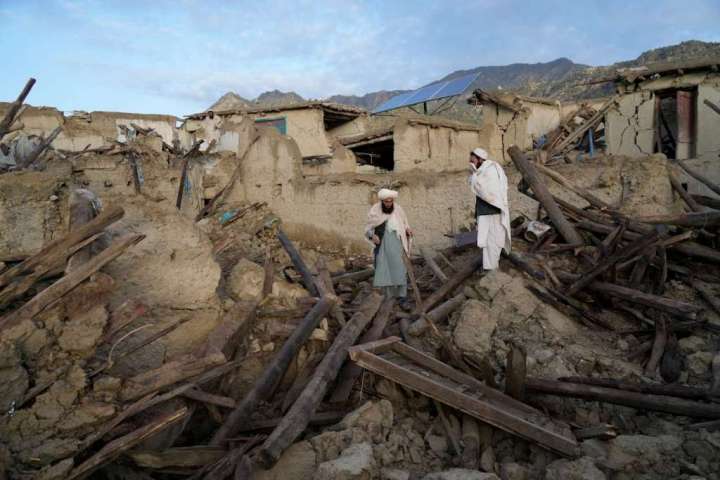On Wednesday, eastern Afghanistan was ravaged by an earthquake, killing more than 1,000 people and injuring 1,600 others, marking the deadliest earthquake in the country in two decades.
Earthquake tech could limit deaths. Afghanistan shows it’s not easy.

These are scenarios that artificial intelligence experts focused on disaster management are trying to prevent. In recent years, there’s been a flurry of technology and research attempting to help governments better predict and respond to disasters like floods, tsunamis and earthquakes.
Researchers are using deep-learning algorithms to filter out city noise so earthquake data can be collected better. Algorithms analyze seismic data from previous earthquakes to predict earthquakes earlier and notify people more quickly.
“AI can be very fast — it can give more warning time for people,” said Mostafa Mousavi, an artificial intelligence researcher at Stanford University who specializes in geophysics and earthquakes. “Even ten seconds can save a lot of lives.”
But the situation in Afghanistan, researchers note, shows the structural challenges artificial intelligence faces in places with crumbling infrastructure.
To learn more, The Washington Post talked with Monique Kuglitsch, chair of a joint U.N. working group focused on AI for natural disaster management, and Mousavi.
This interview has been edited for length and clarity.
What does AI have to do with earthquakes?
Kuglitsch: For earthquakes, there’s real-time forecasting and communicating using AI. That means detecting an event using real-time data streams and projecting what’s going to happen in the next days, weeks, months or seasons. There’s also forecasting or assisting with communication through an early warning system or decision support system.
Mousavi: In more recent years, using deep-learning and advanced artificial intelligence, we see promising results in predicting and forecasting ground shaking. Technology can predict ground shaking intensity based on what seismic monitoring stations have experienced. You can use those observations to forecast in a matter of seconds what the intensity of shaking will be.
In Afghanistan, how could AI have helped?
Mousavi: Because AI can be very fast, it can give more warning time for people. Increasing it to 20 seconds, 30 seconds to a minute. The warning can be very helpful in saving lives, especially in cases like Afghanistan, where most of the buildings in the quake area were poorly constructed one-story buildings. They were not very tall or huge. In that situation, even 10 seconds can save a lot of lives, because people can quickly escape.
Kuglitsch: In the best case scenario, we would know in advance that an event is going to happen. Then when the event happens, we would have an early warning system triggered so that people could evacuate in time. Once the event happens, we would have these sort of decision support tools, dashboards in place, and chat bots that would help communities recover immediately.
What challenges do AI solutions face in countries like Afghanistan?
Mousavi: In Afghanistan, maybe there was not that much of a chance for an AI earthquake early warning system to help. The main problem is that those early warning systems use signals around the area, so it depends on how many station seismic stations or sensors we have nearby the earthquake. In Afghanistan, in terms of data collection, it shows the closest seismic station that exists in that region is in Kabul, which is 150 kilometers away from the earthquake.
Kuglitsch: The first challenge is going to be the availability of data. In Haiti, if I’m not mistaken, they have 10 operating seismic monitoring stations. This is very few for an island that gets hit by some pretty devastating seismic events. Certainly, you also need to have stable communications, infrastructure and electricity — all of these things. You also need computation power to run these models. Anything that we can do to support the development of such infrastructure will be tremendously beneficial for all regions but particularly these regions that are hit the hardest.
What broader challenges do earthquake AI solutions face?
Mousavi: The data that we use [is mostly] subjective. In terms of earthquakes, it’s really hard to say where the earthquake happened, the location, the magnitude. The tools we have for that is just inferring using data and some traditional techniques — but you’re still just estimating. It’s not like a dog picture versus a cat picture, which is much easier to label.
Kuglitsch: There’s very limited long-term data about earthquakes. Instrumental data, seismic records, data from instruments only go back 150 years. And a full earthquake cycle can take thousands of years. You basically need thousands of years of data in order to model an earthquake. We don’t have thousands of years of data. At best, we could maybe get paleo data, which is when you look at what’s happening in sediments and use that to figure out how frequently earthquakes happened.
So for that, we turn to things like our physical understanding of earthquakes and a seismic patterns. And we make these basically like laboratory lab quakes. And we use those in AI based models to basically estimate how they should respond. It’s the best that we have. But certainly, you know, there’s nothing that can replace an instrumental measurement.






